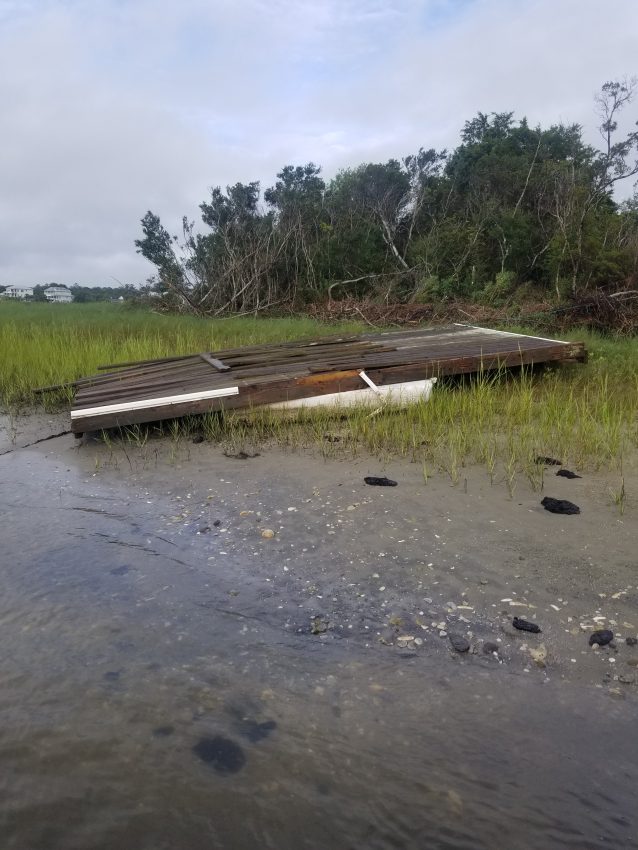North Carolina Coastal Federation and North Carolina Division of Coastal Management partner on large scale marine debris and vessel removal project

WILMINGTON –The N.C. Division of Coastal Management, in partnership with the North Carolina Coastal Federation, received nearly $2 million dollars in funding from the Natural Resources Conservation Service’s Emergency Watershed Protection Program for the removal of marine debris and abandoned and derelict vessels along the southeast and central coast of North Carolina, remnants of Hurricane Florence. DCM’s Coastal Reserve-and National Estuarine Research Reserve program is one of the many public trust areas along the coast that will benefit from the clean-up effort.
“This project, in concert with others being conducted simultaneously, will culminate in the largest organized public lands debris removal effort in North Carolina’s coastal history,” says Paula Gillikin, Central Sites Manager of the DCM’s Coastal Reserve Program.
Working with small skiffs and small crews, local fishermen have been combing through public trust shorelines and into hidden marsh areas of dredge spoil islands to remove large deposits of pressure treated wood, plastic and polystyrene floats, and other debris from docks and waterfront structures damaged by Hurricane Florence. The debris contains harmful chemicals that may affect estuarine habitats and animals, including fish and shellfish consumed by humans. Large deposits of debris pose hazards to navigation, fishers, and marsh vegetation. Field crews have collected almost 74 tons of debris since July from the Division’s Rachel Carson, Permuda Island and Masonboro Island Reserves and Hammocks Beach State Park.
Fisherman Joe Huie and his crew from Sneads Ferry are now working on Masonboro Island Reserve and have removed over 35 tons of debris. These impressive figures will continue to grow as several vessels that were storm-damaged and subsequently abandoned are removed from the site.
“I don’t think people could even perceive how much debris is really out there” said southeast field crew leader Joe Huie, “I believe that if we started debris removal around New River in Onslow County and moved our way down south into Brunswick County, by the time we finished in Brunswick and went back home over the course of a year or less, the places we had originally cleaned would be covered with debris again, and that’s without a hurricane like Florence contributing large amounts.” he said.
Ted Wilgis, regional project lead for the federation added that it is important to realize the simple things people can do to reduce marine debris at home and work.
“During this busy hurricane season, everyone can help reduce property damage and the amount of debris entering coastal waters by following tips such as ensuring trash and recycling cans are empty and secure prior to storms, “ said Ted Wilgis, regional project lead for the federation. Tips like this along with many other, may be found in the NOAA Marine Debris Program’s “Storm Preparedness and Marine Debris” tip sheet.
Household debris and consumer trash only make up about 15-20% of the debris being found. Most of the debris being collected by Huie and the other crews are large pieces of debris like lumber and floats from broken up docks and piers. “People should really pay attention to how these things are being built and maintained along the coast. It would probably be cheaper for the property owner and the public to build these more solid than to replace them with every storm” he adds.
Wilgis notes that there are still hundreds of damaged waterfront structures along the coast that can easily add to the debris problem with just a small storm or a large boat wake. “We encourage owners of these damaged structures to try to secure them as best as possible until they can be removed or repaired.”
The Emergency Watershed Program project is just one of several efforts underway to address marine debris in coastal N.C. Added to the tons of debris are the many vessels that were scattered along the coast during hurricanes and tropical storms Matthew, Florence and Michael and are now considered abandoned and derelict vessels (ADVs). In July, Governor Cooper approved final legislation that updated authorizing language to allow the N.C. Wildlife Resources Commission to remove these storm-related vessels littering the coast. The N.C. Division of Coastal Management, N.C. Wildlife Resources Commission and the federation have assessed and documented abandoned vessels targeted for removal through several funding programs. Vessel removal by specialized contractors is anticipated to begin in late November and will focus on the ADVs from the named storms.
An additional $1 million in state appropriations for the NCWRC will be used to remove vessels left by hurricanes Florence and Matthew. The federation is also receiving funding from the NOAA Marine Debris Program and the National Fish and Wildlife Foundation Emergency Response Marine Debris Program. The latter will fund the removal of dozens of more vessels abandoned in the northeast coastal region. These efforts build on additional funding from state appropriations and the NOAA Marine Debris Program in 2019 that resulted in over 315 tons of debris and several vessels removed from coastal waters.
While hired crews work to remove large scale debris, the federation and Division want to let the public know their help is needed. People visiting Coastal Reserves and other public lands can help by picking up trash when it’s safe to do so and disposing of it properly. Visitors are encouraged to share their finds by tagging “@debrisfreenc” on social media. “I thank citizens in advance for helping collect marine debris at the Reserves and other public lands,” says Rebecca Ellin, Coastal Reserve Program Manager with the Division. “Through collaborative efforts such as these, we can reduce marine debris in coastal NC to protect habitats and enhance the safety and enjoyment of our coastal environment.”
More information on this project and the first ever North Carolina Marine Debris Action Plan can be found here: https://www.nccoast.org/protect-the-coast/marine-debris/
